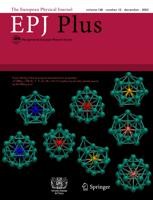A full-scale prototype for muon tomography
Building on previous studies of muon tomography techniques, this topical issue demonstrates a full-scale prototype for the technology, capable of determining the position of a small lead block within a large sensing area
New York | Heidelberg, 1 February 2021
 Each year, billions of tons of goods are transported globally using cargo containers. Currently, there are concerns that this immense volume of traffic could be exploited to transport illicit nuclear materials, with little chance of detection. One promising approach to combating this issue is to measure how goods interact with charged particles named muons – which form naturally as cosmic rays interact with Earth’s atmosphere. Studies worldwide have now explored how this technique, named ‘muon tomography,’ can be achieved through a variety of detection technologies and reconstruction algorithms. In this article of EPJ Plus, a team headed by Francesco Riggi at the University of Catania, Italy, build on these results to develop a full-scale muon tomograph prototype.
Each year, billions of tons of goods are transported globally using cargo containers. Currently, there are concerns that this immense volume of traffic could be exploited to transport illicit nuclear materials, with little chance of detection. One promising approach to combating this issue is to measure how goods interact with charged particles named muons – which form naturally as cosmic rays interact with Earth’s atmosphere. Studies worldwide have now explored how this technique, named ‘muon tomography,’ can be achieved through a variety of detection technologies and reconstruction algorithms. In this article of EPJ Plus, a team headed by Francesco Riggi at the University of Catania, Italy, build on these results to develop a full-scale muon tomograph prototype.
The technology is particularly advantageous since cosmic muons are available worldwide; display well-known properties at sea level; and can penetrate far deeper into heavy materials than x-rays. As they interact with heavy elements such as nuclear materials, muons are scattered at characteristic angles. Therefore, by comparing the trajectories of muons entering and exiting a material being inspected, researchers can identify these elements, even if they are hidden within large containers. However, since cosmic muons are relatively rare, this technique requires long scanning times to produce suitable levels of sensitivity and image resolution – limiting its use in large-scale monitoring. Many previous studies have now addressed this issue using advanced muon detection techniques, alongside image reconstruction algorithms.
In this article, Riggi and colleagues used the insights gained through these studies to build a full-scale muon tomograph prototype, with a sensing area of 18m2 – large enough to inspect a standard cargo container. Their study involved placing light-emitting muon detectors above and below a small lead block. A specialised algorithm then used the data they gathered to estimate the closest approach between nuclei with high atomic numbers within the block, and the muons which were scattered by them – enabling the researchers to determine the position of the block in 3D. The outcomes of the study pave the way for practical detectors with low sensing times and high image resolutions. Through further improvements, the prototype could soon lead to sophisticated monitoring systems, suitable for use in cargo-handling facilities worldwide.
References: F Riggi, M Bandieramonte, U Becciani, D L Bonanno, G Bonanno, P G Fallica, G Gallo, A Grillo, P LaRocca, D Lo Presti, C. Petta, C Pinto, S Riggi, G Romeo, G V Russo, G Santagati, G Valvo (2021), Multiparametric approach to the assessment of muon tomographic results for the inspection of a full scale container, Eur. Phys. J. Plus 136:139, DOI 10.1140/epjp/s13360-020-00970-z
Further Information
For more information visit: www.epj.org
Services for Journalists
The full-text article is available here.
Contact
Sabine Lehr | Springer | Physics Editorial Department
tel +49-6221-487-8336 | sabine.lehr@springer.com
